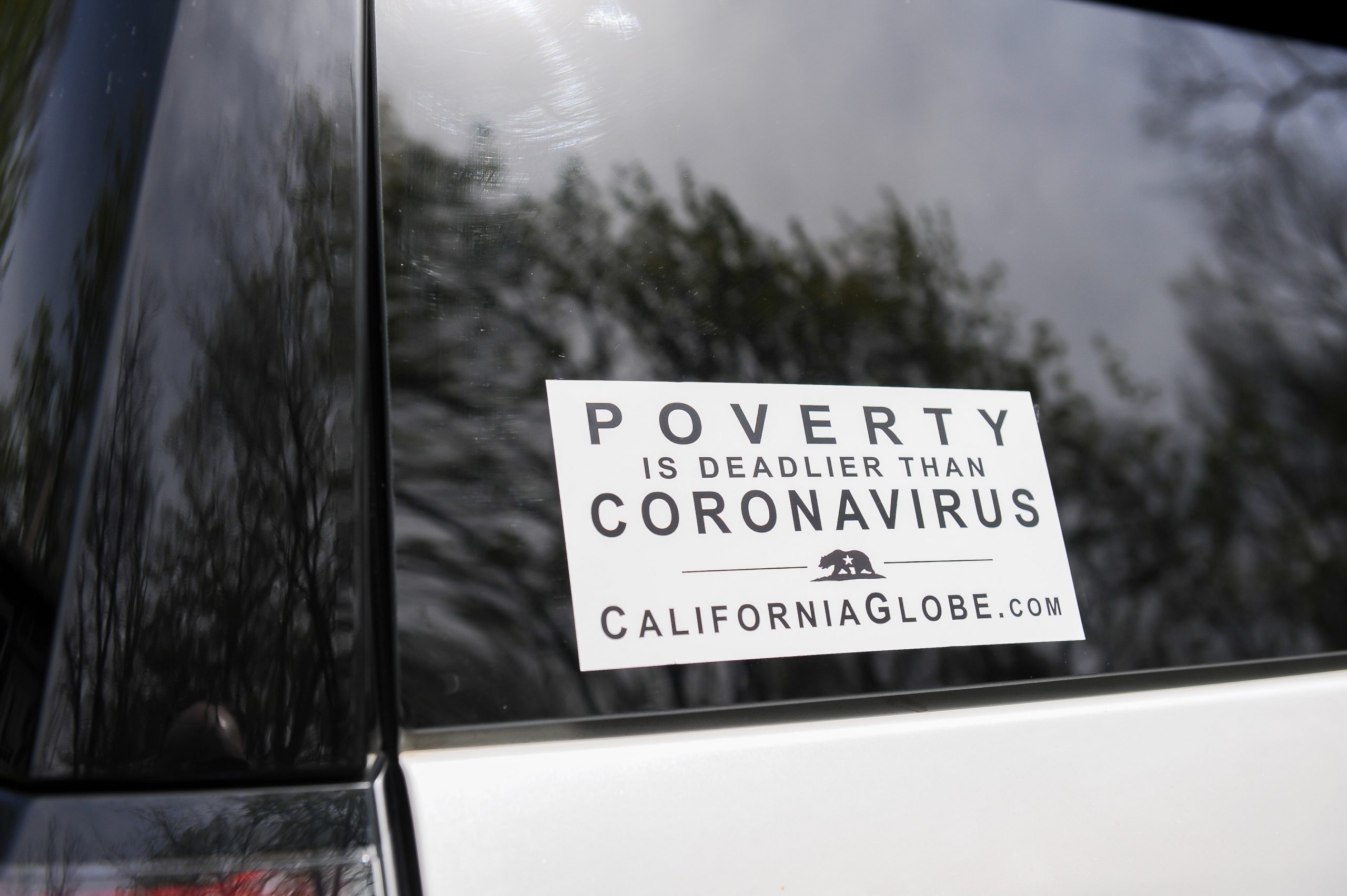
Governor Gavin Newsom speaking with attendees at the 2019 California Democratic Party State Convention at the George R. Moscone Convention Center in San Francisco, June 1, 2019. (Photo: Gage Skidmore)
Ambitious Reforms in Place to Combat Poverty in California
Nearly 1 in 5 Californians live near the poverty line
By Laura Hauther, June 5, 2020 7:31 am
Gone is one of Newsom’s most ground-breaking proposals – expanding coverage for about 27,000 undocumented seniors
When the economy was booming and revenues were high, California made some bold moves to address the state’s crushing poverty rate. Now Gov. Newsom finds himself wrangling with Democrat leaders in the legislature trying to plug the $54.3 billion budget hole in the aftermath of the coronavirus pandemic.
They want Newsom to step back from $14 billion in proposed cuts, hoping to find enough to bridge the gap until an expected aid package from Congress comes through.
Poverty and income inequality have lingered in the state for years, and the official stats are bad enough – 13.3% of the population couldn’t meet basic needs for a family of four, estimated at $24,900.
If that figure looks way too low for a single person, let alone a family of four, that’s because the official national poverty line does not reflect some significant factors, like the high cost of housing in California.
The California Poverty Measure (CPM) created by the Stanford Center on Poverty and Inequality and the Public Policy Institute of California (PPIC) takes a more comprehensive approach to understanding the economic realities of living in California. The CPM factors in both available resources, like various social welfare programs, and adjusts for the higher costs.
Under this measure, 17.8% of Californians were under the $32,500 needed to rise about the poverty line.
Nearly 1 in 5 live near the poverty line, and close to 4 in 10 California residents were deemed poor or near poor.
The good news is there was a substantial decline in the poverty rate after 2017. The bad news is that these gains have been lost and then some in the wake of COVID-19.
Though California along with the rest of the country has a pretty bleak economic outlook for the near future, Sacramento was starting to use some of the economic gains from the past few prosperous years to address poverty and income inequality in the state.
The CPM shows CalFresh – California’s food stamp program – and the state and federal Earned Income Tax Credit (EITC) are the most effective programs for helping move people out of poverty.
California passed one of the most progressive state EITC programs last year – the income cap was from raised from $10,000 a year to $30,000, and includes an extra $1000 for households with a child under the age of 6. A proposal to extend this to undocumented households this year didn’t make the cut.
The legislation was poised to make more significant changes to programs aimed at the poor at the end of 2019 but those that didn’t get signed into law or have a line in the budget got wiped out in the wake of virus-induced budget shortfalls.
As late as January, Gov. Newsom proposed a sweeping expansion of Medical benefits and services for poor Californians that are now endangered.
Gone is coverage for some dental services, diabetes prevention programs, physical therapy, hearing exams and eyeglasses -as well as any services not currently mandated by the federal government – saving the state $54.7 million.
Other changes include reverting to a former, more punitive version of the estate recovery policy, allowing the state to go after repayment from a person’s estate after death.
In a blow to the state’s seniors, a proposal to get rid of the “senior penalty” is gone. The penalty requires older, blind and disabled Californians to pay a share of cost toward their care at a lower income level than most other adults – $15,500 v. $17,600. The result is medical bills that can stretch their already limited resources to the breaking point.
Also gone is one of Newsom’s most ground-breaking proposals – expanding coverage for about 27,000 undocumented seniors. Coverage currently in place for undocumented children and young adults (up to 26) remains unchanged. This move saves $113 million.
But the biggest blow was the end of the program Newsom called the “centerpiece of (his) state of the state,” according to CalMatters.org. The Medi-Cal Healthier California for All or CalAIM program would have put more emphasis on comprehensive and preventative care, providing basics like housing and food services.
The overall Medical budget is $112.1 billion, which is actually $5 billion larger than the proposed budget in January. Those funds are now needed to provide basic care to a record breaking 14.5 million people projected to be on the rolls by July of this year as the newly unemployed apply for benefits.
The one ray of hope: Many of these cuts could be reversed if more funding flows from Washington. Given Trump’s vow to completely dismantle “Obamacare” even in the face of the pandemic and the tense state of relations with Washington, it may take some wrangling to make that happen.
But California renters can rejoice, including many who are struggling to keep their housing right now. Gov. Newsom recently extended eviction protections through July 28th and many have new protections against rent increases and eviction.
A landmark rent stabilization bill, AB 1482 or the Tenant Protection Act (TPA) of 2019, went into effect in January. The bill, authored by David Chiu, D-San Francisco, caps rent increases at 5% plus inflation and requires specific “just cause” reasons for evictions.
Its estimated 2.4 million units will be covered until the law expires in 2030.
Application of the law can get a little complicated in areas already covered by the Costa-Hawkings Rental Housing Act. The TPA targets units built more than 15 years ago that have two or more units and not currently subject to Costa-Hawkings rules.
Most single-family homes, townhouses and condos are exempt except those owned by REITS or corporations. Duplexes with an owner-occupied unit escape the new caps as well.
The California Apartment Association negotiated two provisions in the new law. They pushed the required age of the buildings back from 10 to 15 years old and got a ban on local governments mandating tighter rent increase restrictions if they’re covered by the TPA. Landlords can also raise rents without restriction when a tenant moves out.
The “just cause” provisions for eviction include pretty standard fare: nonpayment of rent, assigning or subletting, substantial renovation, and having a family member move into the unit are among the nine reasons allowed.
But those protections don’t kick in until a renter has lived in the unit for 12 months, and that gets extended if a roommate moves in during the first 24 months.
Assemblywoman Autumn Burke’s (D-Inglewood) proposed right to housing bill (AB 2405) goes even further. The focus of Burke’s legislation is children and families. It provides protections like rental assistance, eviction defense and emergency shelter.
Even though the coronavirus pandemic has made financing such protections more difficult, co-author and chair of the Housing Committee David Chiu, (D-San Francisco) told KQED, “It’s the moral thing to do. It’s the human thing to do. It’s also, during this pandemic, the right thing to do for public health.”
And thanks to Sen. Holly Mitchell, a Los Angeles Democrat – recipients of Section 8 can no longer be rejected just for using assistance. These anti-discrimination provisions require a landlord to count all legitimate sources of income when considering an applicant.
Homelessness
After years of discussion and debate on how to deal with the increasing number of Californians experiencing homelessness, the COVID-19 pandemic finally forced the issue. In order to stem the number of cases, Newsom and local governments throughout the state created Project Roomkey to find and secure 15,000 hotel and motel rooms for those testing positive or most at risk for contracting the novel coronavirus.
The plan uses the $750 million from a federal relief package to support these businesses and their employees, while providing much needed shelter for the most vulnerable during the pandemic.
Recipients can stay in hotel or motel rooms for three months but the ultimate goal is provide permanent supportive housing. The state plans to turn over The Project Roomkey properties to local governments for that end now that $1 billion has been cut from the Newsom’s proposed homelessness fund that would have provided rental assistance, more affordable housing and more board and care homes.
The new budget may be disappointing for legislators who wanted to make deep changes to the how the state deals with its most vulnerable. But it’s clear that some ambitious reforms are in place to help Californians head back toward some version of normalcy.





Ms. Hauther writes about the cuts to numerous “programs” as though it were a bad thing, and therein lies the perpetual problem.
They will never succeed because they don’t want to succeed. Dems need poverty to rile up the mobs so they will double down on job killing and importing illiterate, unskilled illegals to go onto welfare and to take jobs from blacks.